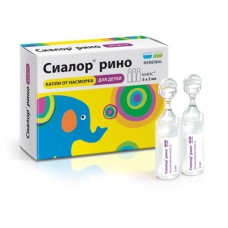Expiration date: 03/2026
Composition
1 ml contains Oxymetazoline hydrochloride 0.5 or 1 mg
Excipients: benzalkonium chloride 0.15 mg, disodium edetate (Trilon B) 0.5 mg, sodium hydroxide solution 0.1 M to pH 6.0-7.0, sodium phosphate odnosemjannyj dvuvodny 1.29 mg; sodium disodium phosphate 12-water 1.76 mg, purified water to 1 ml.
Pharmacological action
Oxymetazoline belongs to the group of alpha-agonists for topical application. Has a vasoconstrictor effect. In intra reduces swelling of mucous membrane upper divisions respiratory tract, which leads to relief of nasal breathing and opening of the orifices of the paranasal sinuses and evstafievich pipes. The action of the drug is 5 minutes after application and lasts for 8-12 hours.
Pharmacokinetics
The local application of Oxymetazoline is practically not absorbed.
Side effects
Burning or dryness of the mucous membranes of the nasal cavity, dry mucous membranes of the mouth and throat; sneezing; increase in secretion produced from nose; after the effect of the drug, a strong sense of "stuffiness" of the nose (reactive hyperemia).
Side effects due to systemic action of the drug: increased blood pressure, headache, dizziness, palpitations, tachycardia, increased anxiety, sedative effect, irritability, sleep disturbances (in children), nausea, insomnia, rash, blurred vision (with eye contact). With long – term use tachyphylaxis, reactive hyperemia mucous membranes and atrophy of the mucous membrane of the nasal cavity.
The preservative benzalkonium chloride, which is part of the drug can be the cause of swelling of the mucous membrane of the nasal cavity. If this happens, you must change to another drug that does not contain preservatives.
Method of application
The intranasal route. Adults and children over 6 years: apply 1-2 drops 0.05% solution in each nostril 2 - 3 times a day. Children from 1 year to 6 years: use 1-2 drops of 0.025% solution in each nostril 2-3 times a day. Children under 1 year of age: children aged up to 4 weeks prescribed by 1 drop of 0.01% solution in each nostril 2-3 times a day. From the 5th week of life and up to 1 year – 1-2 drops in each nasal passage 2-3 times a day. It is not recommended to use the drug for more than 7 days. Frequent and prolonged use of the drug a feeling of "stuffiness" of the nose may reappear or get worse. If you encounter these symptoms should stop treatment and consult a doctor
Overdose
Symptoms: nausea, increased blood pressure, tachycardia, Central nervous system depression. Treatment: symptomatic.
Special conditions
At the recommended dose without consulting a doctor to use a maximum of 7 days. If symptoms increase or improvement does not occur within 3 days, you should consult with your doctor.
To avoid preparation hit in eyes.
To avoid infection you need to use the drug individually.
After opening, use within 14 days.
The ability to influence on reaction rate when driving motor transport or operating other mechanisms
In the application of Oxymetazoline in doses exceeding recommended, may occur increased blood pressure, tachycardia or depression of the Central nervous system. In these cases, the ability to operate a vehicle or equipment may be reduced.
Testimony
- treatment of acute respiratory diseases accompanied by rhinitis;
- allergic rhinitis;
- vasomotor rhinitis;
- to restore the drainage in the inflammation of the paranasal sinuses of the nasal cavity, Eustachian, otitis media;
- to eliminate edema before diagnostic procedures in the nasal passages.
Contraindications
- hypersensitivity to the drug;
- atrophic (dry) rhinitis;
- inhibitors of monoamine oxidase within the preceding 2 weeks and for 2 weeks after their cancellation;
- angle-closure glaucoma;
- status after transsphenoidal hypophysectomy;
- children up to age 1 year – for drops of 0.025 %;
- children up to age 6 years for drops 0,05 %;
- pregnancy;
- lactation.
With caution
In patients suffering from diseases of cardiovascular system (arterial hypertension, ischemic heart disease, congestive heart failure, tachycardia, arrhythmia), disorders of carbohydrate metabolism (diabetes), disorders of thyroid function (hyperthyroidism), pheochromocytoma, chronic renal insufficiency, prostatic hyperplasia (urinary retention) and the receiving tricyclic antidepressants and bromocriptine.
Use during pregnancy and breastfeeding
The drug should be used only after careful evaluation of the balance of risks and benefits for mother and fetus.
Drug interactions
While the use of inhibitors of monoamine oxidase (including the period within 14 days after their withdrawal) and tricyclic antidepressants may experience increased blood pressure.
The drug slows the absorption of local anaesthetic drugs, extends the effect.
Joint appointment other vasoconstrictor drugs increases the risk of side effects



